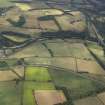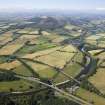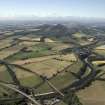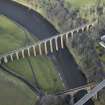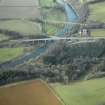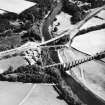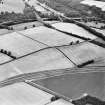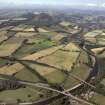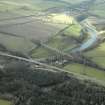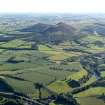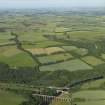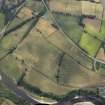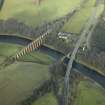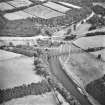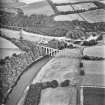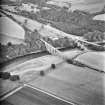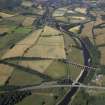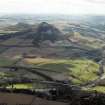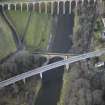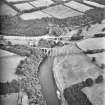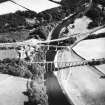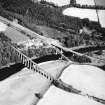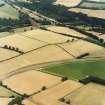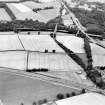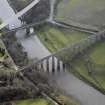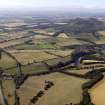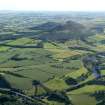Drygrange, New Bridge
Road Bridge (20th Century)
Site Name Drygrange, New Bridge
Classification Road Bridge (20th Century)
Alternative Name(s) River Tweed; Leaderfoot Road Bridge; 'tripontium'; Bridge Pool
Canmore ID 55690
Site Number NT53SE 77
NGR NT 57576 34664
Datum OSGB36 - NGR
Permalink http://canmore.org.uk/site/55690
- Council Scottish Borders, The
- Parish Melrose
- Former Region Borders
- Former District Ettrick And Lauderdale
- Former County Roxburghshire
NT53SE 77 57576 34664
For (adjacent) predecessor bridge, see NT53SE 67.
For adjacent railway viaduct, see NT53SE 76.
Leaderfoot Road Bridge was built in 1971-3 by Sir Alexander Gibb and Partners. As utilitarian in its own way as the adjacent Victorian structure (NT53SE 76); time will tell whether its box girder construction will prove as robust.
This bridge forms part of the group known irreverently as Tripontium.
C A Strang 1994.
This bridge carries the present line of the A68 (T) public road over the River Tweed a short distance above its junction with the Leader Water.
The location assigned to this record defines the centre of the span crossing the Tweed. The available map evidence suggests that it extends from NT c. 57600 34540 to NT c. 57562 34831. It crosses a minor public road to the N of the river.
Information from RCAHMS (RJCM), 14 October 1997.
Publication Account (1985)
For most of history and prehistory the most important north-south route in south-east Scotland lay through Lauderdale, and around the meeting of the Leader Water and the River Tweed it met its most difficult natural barrier. The Tweed, however, was fordable a little to the west and where the Roman trunk road, later Dere Street, was able to cross the river there grew
up perhaps the most important Roman fort in Scotland, Newstead or Trimontium.
In more recent times the main road and rail routes have followed the coastal route to the east but the A 68 is still a key line of communication to north-east England and the most recent 3-span road bridge stands alongside its predecessor, built between 1776 and 1780 and described in 1798 as that very substantial and elegant [structure] over Tweed at Drygrange, whose middle arch has a span of 105 feet" (32 m).
This rubble-built bridge has 4 spans. Only the large main arch is segmental; it is flanked by smaller semicircular arches with a sizeable arched recess at the southern end. The cut-waters support piers which
terminate in triangular refuges for pedestrians crossing the bridge; and these piers, like the outer walls above the main arch, contain attractive carved decoration. Most prominent are the sculpted urns set within circular panels. From the line of the projecting stone corbels above, it is clear that the parapets have been raised to make for a more level roadway.
A little to the west stands the tall, graceful, single-track Leaderfoot railway viaduct. Built of an attractive pinkish-red sandstone, its 19 semicircular brick-lined arches rest on slender stone pillars, subsequently reinforced with buttresses. Opened in 1865 for the Berwickshire Railway, and long abandoned, it linked places such as Earlston, Greenlaw, Duns and Chirnside both with the main east-coast line at Reston and with the Waverley route from Edinburgh to Carlisle, just south of Leaderfoot - a route which for largely industrial reasons (the location of the Midlothian coalfield) passed down the valley of the Gala rather than the Leader Water.
Information from 'Exploring Scotland’s Heritage, Lothian and Borders’ (1985).
Publication Account (2007)
The present bridge is a modern composite steel box girder and concrete deck bridge. It was designed by Sir Alexander Gibb & Partners and built in 1971–73 by Miller Construction (Northern) Ltd with steelwork by Clarke Chapman Ltd. It has a main river span of 187 ft with subsidiary spans giving a total length of 640 ft. The twin box girders are 12 ft by 5 ft at the piers reducing to 5 ft by 5 ft at midspan, to give a curved soffit profile. The girders were assembled on site using high strength friction grip bolts.
R Paxton and J Shipway 2007
Reproduced from Civil engineering heritage: Scotland - Lowlands and Borders' with kind permission from Thomas Telford Publishers.
Sbc Note (15 April 2016)
Visibility: Standing structure or monument.
Information from Scottish Borders Council






































